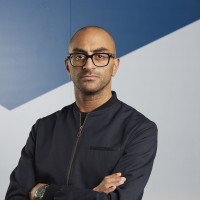Ramy El-Bergamy’s job is to make Channel 4’s programmes reflect the true diversity of our society. In an exclusive interview with Community Living, he explains to Simon Jarrett what that means.
 Ensconced in Channel 4’s futuristic London headquarters Channel 4’s On-screen Diversity Executive Ramy El-Bergamy has a big job on his hands. He has to ensure that the Channel’s ‘360° Diversity Charter’ will translate into a real change on-screen.
Ensconced in Channel 4’s futuristic London headquarters Channel 4’s On-screen Diversity Executive Ramy El-Bergamy has a big job on his hands. He has to ensure that the Channel’s ‘360° Diversity Charter’ will translate into a real change on-screen.
In every aspect of the Channel’s output – drama, documentaries, reality programmes and game shows – we should be able to see a range of people who reflect the society we live in, rather than just one part of it. This means that not only should we be seeing the whole spectrum of ethnic and gender diversity, but also the full range of disability and impairment, that we know is out there. There should be no excuses – why on earth should a television channel not reflect the audiences it’s broadcasting to?
Making the Charter a reality
El-Bergamy came to Channel 4 in 2015 with a ten-year broadcasting background, having worked on programmes such as Big Brother, The Voice and Geordie Shore. With his colleague Nina Bhagwat, the Off-Screen Diversity Executive, the brief is to make the Charter a reality. For El-Bergamy this is about ensuring that what we see on-screen changes. For Bhagwat it involves working closely with independent and in-house producers to improve their organisational diversity. For example,10 per cent of the approximate 300 production team for the Rio Paralympics will be people with disabilities – a specific commissioning demand by Channel 4.
What chances of success for El- Bergamy, and what about the minority that often gets missed out even by other minorities – people with learning disabilities? He points to recent successes such as Paul Abbot’s No Offence and Undatables. Both risked controversy, Undatables through its title and No Offence through its plotline, which involved a serial-killer who was stalking women with Down’s syndrome. Its cast of actors with Down’s syndrome took on roles that challenged stereo-types, including male prostitutes and characters who drank and swore just as much as, if not more than, the police they became involved with. Both largely won over their critics, drawing huge audiences. No Offence is now showing in France to audiences of over five million.
This isn’t worthy television, it’s highly successful commercial television, and that is a point El- Bergamy is keen to make. Those who damn all of this as tokenism or political correctness, he points out, are often those middle-class white males who have most to lose from increased diversity on-screen and elsewhere. The audiences, he insists, never have a problem. The viewing figures show that whenever diversity becomes a feature of a programme, so long as it’s good viewing in its own right, audiences respond by watching in their millions.
Threats to diversity
El-Bergamy sees two threats to diversity that have to be tackled. The first is structural. TV production is a small, demanding world with quick turnarounds. Independent production companies will get a call asking them if they can deliver something in six weeks. In such circumstances, they turn to those they already know which perpetuates existing imbalances of representation. Those on the outside are unable to get in, leading to a mistaken perception that there are few talented disabled people out there.
To counter this, the diversity team are trying to build relations and connections between producers and disabled actors during the quieter times, rather than having to undertake desperate and often futile searches when a commissioner is screaming down the phone for a deadline to be met. It was in this way that Richard Hayhow of Open Theatre Company was able to identify the acting talent for No Offence and then work with them on-set to ensure a successful production.
The second threat, as El-Bergamy sees it, is simple prejudice or, to put it more kindly, unconscious pre-judgement. Disabled actors are seen as representatives of all disabled actors. If a programme featuring them flops, it is seen as a sign that programmes involving disabled actors don’t work. It is not considered that the programme itself, or the actor, may not have been very good. No Offence was a risk but then a success – what would have happened to the perception of learning disabled actors, El-Bergamy ponders, if the programme had flopped? Disabled actors have to work twice as hard to be considered half as good and carry the weight of thousands of hopefuls on their shoulders.
Simple insight
El-Bergamy offers a simple insight. If you are a learning-disabled person on television, you shouldn’t have to be an ‘issue’. You can be in a story, just like you can be in real life, simply because you are there – you don’t have to symbolise something, or be a plot device to show how wonderful or terrible other people are. You shouldn’t be expected to add something weighty to the narrative. You can be on the television just being who you are.
Channel 4 should be commended for its bold initiative, and Ramy El-Bergamy for the energy and drive with which he is tackling it. It will be a great day when a learning disabled actor wanders on to our screens, and none of us feels the need to comment.
